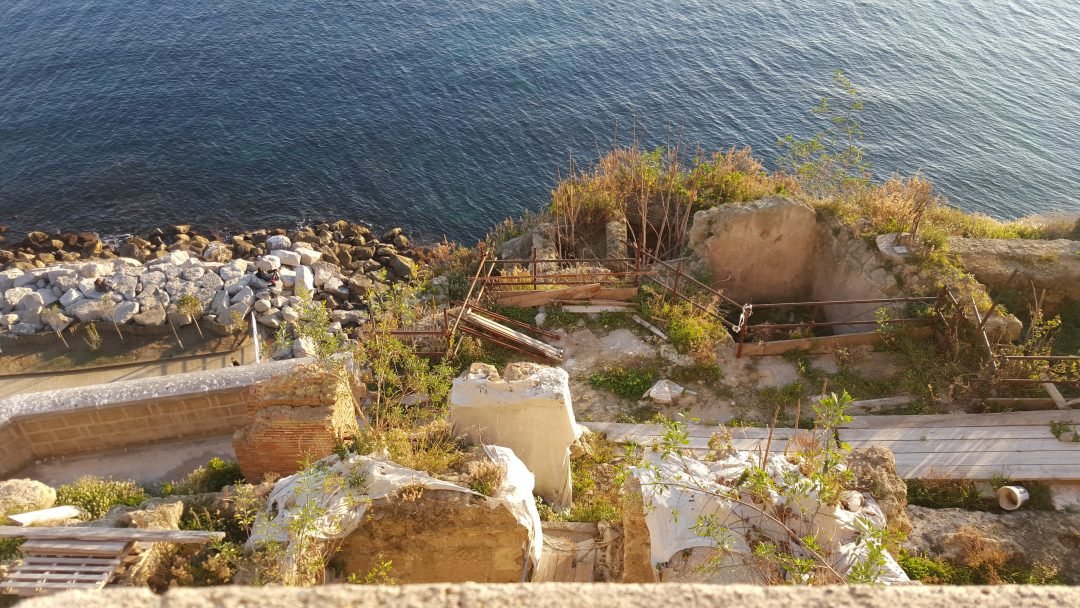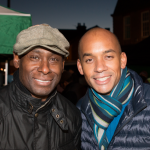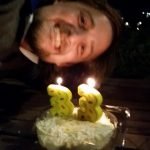
If any place could symbolise how forces beyond your control can sweep into your life, bringing destruction, change but also surprising new opportunities and hope for the future, Pozzuoli’s Rione Terra, in the heart of Campania’s Campi Flegrei (Phlegrean Fields), is that place.
The volcanic area of the Campi Flegrei is drenched in fascinating myth, history and geological phenomena. It’s where I was lucky enough to spend most of my teenage school holidays with my family, Mariacristina and I got married and now visit regularly to spend time with her family (as well as to enjoy the fabulous food, gorgeous weather and beautiful setting). There is so much at which to wonder: from the purported entrance to Dante’s underworld at Lago Averno and the cave of the Sibyl overseeing the oracle at Cuma; via the Roman ‘temple’ of Serapide (actually a marketplace) and Flavian amphitheatre in Pozzuoli; to the fuming volcanic crater of the Solfatara and the continuing threat of significant vertical shifts in the land (clunkily named ‘bradyseism’). And that all just scratches the surface.

It was a particularly large manifestation of the last of these that led to the mass evacuation of the Rione Terra – the heart of Pozzuoli through the ages – in 1970, since when the area has been a ghost town, albeit teeming with history and culture. It turned the lives of its inhabitants upside down, and although the buildings are slowly being restored to their former glory, it will never be the same. But it also enabled eye-opening excavations that revealed the old Roman settlement, well-preserved and forming the foundations of the buildings built on top of them by subsequent inhabitants.
The tour we went on was astonishing: to wander the roads walked by the Romans (their existence brought to life by clever video projections), beneath the abandoned homes of later generations, in the very centre of Pozzuoli, was like drowning in history and culture. And then to emerge and stroll down the narrow streets of the Rione Terra, the stunning colours of the beautiful, reconstructed homes burning brightly against the clear blue sky: it felt as though we were in another world. Go, if you can: the (free) tours are running on Saturdays and Sundays until 27th March – book here (watch the video below to get an idea).

Of course, it also made me think. The continual vertical shifts in the land are like the ups and downs of life: you know they’re there, and you can’t control them all, but at any point they might reach a level that threatens to destroy everything – like a cancer. Emergency plans are put in place to protect life, but they cause a lot of pain. Lives are turned upside down. A lot of what is destroyed will never be recovered – but just as my hair has come back, the gorgeous buildings are returning to life. Since my treatment, I’ve enjoyed unexpected opportunities that, like the Roman ruins revealed by the evacuation, might never have been possible otherwise. These include amazing people I’ve met; events such as the Transplant Games; featuring in a campaign at the House of Commons, legitimate reason to talk about myself to strangers…
The Rione Terra is still there, swelling with history and hints of its former majesty, in some ways all the more impressive as a result of the challenges it has faced. For centuries it was a thriving town centre; now its greatest glory is as a cultural attraction – and who knows what the future has in store?
I, too, have faced a destructive threat and been through painful changes in order to save my life. I’ve lost some certainties and in some ways been knocked backwards, but I’ve also discovered new opportunities and strengths. My life has changed with me, but I still carry the memories, lessons and heritage of life before cancer within me. I may never have had the commercial, residential and historical significance of the Rione Terra – or the beauty! – but with time I’m recovering as much of what I had as I can. What I have to give may not be the same – but perhaps my experiences mean I now have even more to offer…













